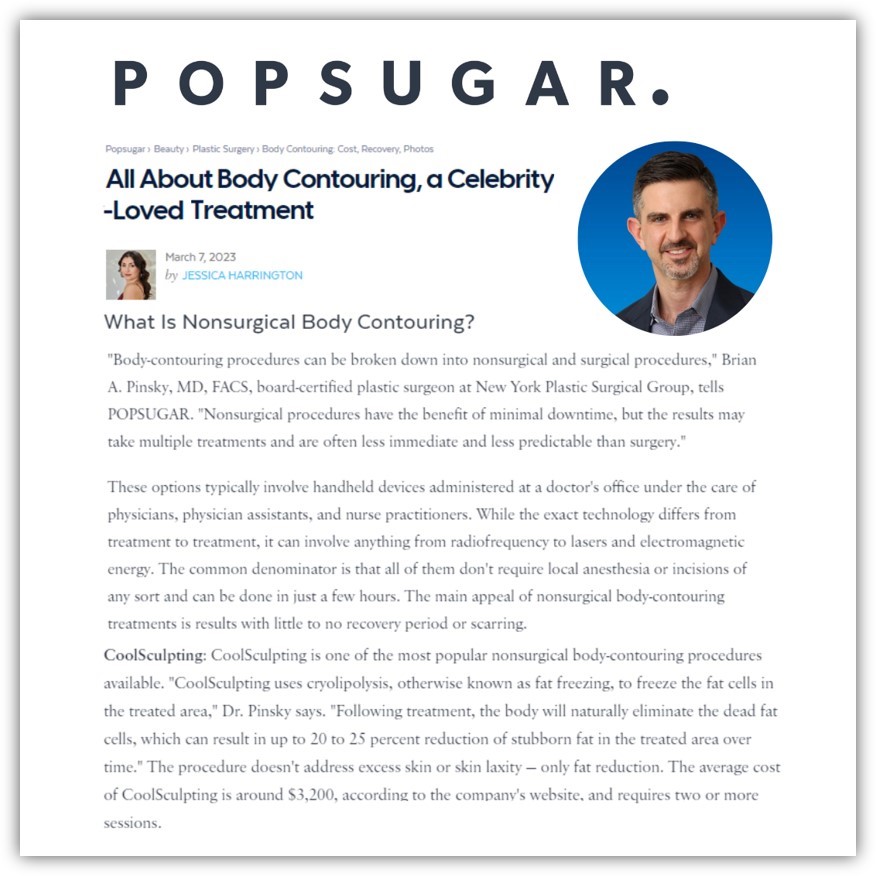In this blog, board-certified plastic surgeon Brian A. Pinsky, MD, FACS outlines the different types of body contouring available, both surgical and non-surgical. He was recently quoted on PopSugar beauty in the article All About Body Contouring, a Celebrity-Loved Treatment.
Body contouring can be broadly defined as any medical or surgical procedure designed to reshape or improve the contour of any area of the body. Patients seeking body contouring often have a history of significant weight loss, pregnancy, or other age-related changes to their body that result in sagging skin, localized fat deposition, and loss of proportion. The goal is to remove excess skin and fat while improving the shape and soft tissue support of the areas of concern. The results should be a smoother, more proportionate, and natural-appearing body.
Body contouring procedures can be broken down into non-surgical and surgical procedures. Non-surgical procedures have the benefit of minimal downtime, but the results may take multiple treatments and are often less immediate and less predictable than surgery. Common surgical body contouring procedures are:
1) Brachioplasty – upper arm lift
2) Abdominoplasty – “tummy tuck”, removes excess lower abdominal skin, tightens abdominal muscle separation
3) Mastopexy – breast lift
4) Lower Body Lift – corrects sagging skin of the buttock, abdomen, and outer thighs
5) Upper Body lift – corrects sagging skin of the upper back and bra roll
6) Medial thigh lift – corrects excess skin and fat of the inner thighs
7) Liposuction – often done with other procedures to improve shape and contour, can be done by itself in patients with good skin quality
8) Facelift – Corrects sagging and loose skin of the mid-face, jowls, and neck
Liposuction is a powerful tool that removes fat only below the skin with small cannulas. The outcomes from liposuction alone depends on the skin’s inherent elasticity to shrink down over time. This can be very limited or unpredictable in cases of weight loss or pregnancy where patients often have very loose, crepey skin or stretch marks that indicate loss of elasticity. It is more appropriate in younger patients with firmer skin and minimal excess. There are skin tightening modalities such as radiofrequency, ultrasound, or laser which can be used as an adjunct to surgery or liposuction. However, these are not a replacement for skin removal in most cases. Liposuction is frequently done in combination with other body contouring surgeries such as an abdominoplasty, body lift, or brachioplasty. With proper technique, the addition of liposuction can improve the contours to highlight the underlying muscle structures and help take the results to the next level. The fat harvested from liposuction can also be used as to inject into areas such as the breast or buttocks for a permanent, natural enhancement of shape and volume.
The surgical consultation for body contouring should involve a detailed discussion between the patient and the surgeon. It’s important that the surgeon understand the goals for each patient to personalize the surgical treatment plan. Patients should be generally healthy, non-smoking, and at their lowest stable weight for 3-6 months. The surgeon should examine the patient’s body to look for the amount and distribution of skin excess, skin quality, prior scars, hernias, or anything else than affect the surgical plan or risk profile of the patient. It’s critically important that the patient has all of their questions or concerns addressed, and that they feel comfortable with the surgeon’s plan. The expected outcomes and post-operative recovery should be discussed in detail. Patients need to understand the normal recovery process, and when they can return to activities such as work and exercise. Most patients return to office work in two weeks, manual labor jobs may take longer.
Body contouring surgeries are typically performed on an outpatient basis at a hospital or accredited ambulatory surgery center. Surgeries that combine multiple body areas or take longer than 4-5 hours may benefit from an overnight hospital stay for monitoring. Body contouring surgery on multiple areas of the body can be combined safely, but it is up to the experience and judgment of the surgeon. The goals should be to keep operative times around six hours to limit potential complications.
The surgery begins with the pre-operative marking where the surgeon plans the location of incisions, and the amount of skin to removed, and areas of contour for liposuction. The patient will then be taken to the operating room where anesthesia is administered by a board certified anesthesiologist. The planned surgery is then completed followed by the placement of dressings and compression garments if needed.
Non-surgical procedures, such as CoolSculpting, are typically done in the office setting, and can be performed by physicians, PAs, NPs, or other trained physician extenders. Coolsculpting uses cryolipolysis, otherwise known as fat freezing, to freeze the fat cells in the treated area. Following treatment, the body will naturally eliminate the dead fat cells, which can result in up to 20-25% reduction of stubborn fat in the treated area over time. However, Coolsculpting is not for everyone as it does not address excess skin or skin laxity.
As with any surgical procedure, the results of body contouring surgeries are permanent. The final outcome generally takes 3-6 months or longer for all edema to resolve, skin to tighten, and scars to mature. Post-operative lymphatic massage can help speed recovery, increase patient comfort, and improve outcomes. The longevity of the result is affected by individual factors such as age, genetics, weight fluctuations, and lifestyle. Exercising regularly and maintaining a healthy diet can even improve surgical outcomes over time. Revision surgery can be needed or desired by patients, and often depends on the age of the patient and severity of the deformity at the initial procedure.
Surgery, unfortunately, has inherent risks. Most of the complications from surgery are relatively minor and related to wound healing. These can include infections, bleeding, fluid collections, and wound breakdown. Most minor complications can be managed with simple office procedures, antibiotics, and wound care. Very rarely, an urgent or emergent surgery can be needed. More serious complications such as DVT/PE are thankfully rare and treatable.
Although excellent results can be expected from any body contouring surgery, there is no guarantee. In some cases, it may not be possible to obtain the ideal result in a single surgery, and a second operation may be needed. Patients interested in body contouring should seek a consultation with an experienced Board-Certified Plastic Surgeon. The outcomes of body contouring surgery can be life changing.


